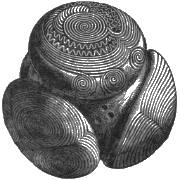NMS Archaeology Object 642650: X.2005.27.9 - Pottery / food vessel
Description
Summary
Intact, small, slender tripartite vase food vessel, from cist K, Holly Road, Leven, Fife
Accession Number
X.2005.27.9
Other references
| Classification number | X.EQ 1121 |
|---|
Original description
[One of] Finds from excavations at Holly Road, Leven, Fife. ORF: IDENTIFICATION - Description: Finds from excavations at Holly Road, Leven, Fife. Description (after published catalogue entry by Sheridan): Intact, small, slender tripartite Vase Food Vessel. Its position suggests that it might have been discovered and repositioned by the diggers of that ditch. There is minor, ancient surface abrasion at the rim and the base-wall junction area, and some minor cracking. In profile, the pot is slightly asymmetrical: the base does not lie centrally below the rim, giving the pot a lopsided appearance. The rim is very slightly everted, with a shallow dished internal bevel. The neck is straight and slightly inverted; kinking out at the rim and the upper shoulder; between the latter and the lower shoulder the body is concave. On one side of the pot the belly narrows evenly towards the base while, on the other, it is concave; both sides narrow to a low pedestal. The base is flat internally and externally. The rim bevel and the entire exterior surface are decorated with fairly shallow and broad cord impressions (up to 3.5mm wide), with the cord twisted to differing degrees of tightness. Individual threads can be seen in some of the impressions. The design is looser and less neat than X.2005.27.4 (X.EQ 1116), X.2005.27.6 (X.EQ 1118) and X.2005.27.7 (X.EQ 1119). The rim bevel has two concentric lines of tightly-whipped cord impressions, with short vertical stretches on the outer edge of the rim. Similar, more widely-spaced, vertical lines adorn the upper shoulder, while the lower shoulder has a short stretch of vertical thumbnail impressions. The neck has four horizontal lines of which the lower two are discontinuous, not always horizontal, and interrupted by irregularly- spaced vertical lines. The area between the two shoulders has a running vertical chevron design which breaks down into a jumble of lines over part of the pot’s circumference. Below the lower shoulder is an equally untidy running chevron or criss-cross design. Further down the belly there is a row of short diagonal stretches of impressions, and just above the base there are two horizontal lines. The exterior is pinkish-buff in colour and the interior is similar but slightly greyish; the core is not clearly visible but appears to be darker. The surfaces had been smoothed and slipped prior to decoration; stone inclusions are visible on the inner surface. These are angular fragments of a speckled, crystalline black and white stone comparable to those in X.2005.27.4 (X.EQ 1116); the largest are around 4 x 3.5mm in size and the density around 5–7%. There are no traces of any former contents. Dimensions: height: 108mm; rim diameter: 107-112mm; base diameter: 59; wall thickness: 10-26mm. Context: Cist K: found upright immediately outside Cist K protected be stones from the backfill of the post- medieval ditch. FIELD COLLECTION - Place: Holly Road, Leven, Scoonie (Kirkcaldy), Fife. Grid Reference: NO 3783 0213. Site Type: Cist cemetery. Period: Bronze Age. Method: Excavation. NMRS no: NO30SE 1. Circumstances of Discovery / Notes: Excavations were undertaken in advance of the development of an area to the N of Leven where a cist burial was discovered in 1944. The recent investigations revealed an enclosed cist cemetery, radiocarbon-dated to the first two centuries of the second millennium BC. The cemetery appears to have had a short period of use when it received inhumation burials inside the ditched enclosure. A number of cists of poorer construction were uncovered outside the enclosure and a Neolithic cremation deposit was retrieved from within the ditch (Author’s abstract). In addition to the fusiform bead from the 1944 investigations (already registered as NMS: EQ 944), the cemetery produced the following: in Cist A were a flint knife, a fossil crinoid that had been used as a bead, and a Vase Food Vessel; in Cists B, C and K, one Vase Food Vessel each (with parts of two others being found in disturbed positions); and in Cist H, an unusually-shaped pebble that had probably been used as an amulet. NOTES and DOCUMENTATION - Bibliographic Reference: Christie, R L 'Short cist at Durie, Scoonie, Fife', Proc Soc Antiq Scot, 83 (1948-9), 230-1. Lewis, J and Terry, J ‘The excavation of an early Bronze Age cemetery at Holly Road, Leven, Fife’ Tayside & Fife Archaeological Journal 10 (2004). Registered / Completed By: Trevor Cowie. Date: 28.8.2006.
Associated person/people (e.g. excavator/former collection)
None
Discovery / field collection
Date of discovery
2002
Method (e.g. excavation)
Excavated
Place (i.e. location of discovery)
Leven, Fife, Scotland, Northern Europe
Grid reference
Not recorded
Acquisition
Acquisition date
2005
Acquisition source (i.e. name of donor)
Unknown
Acquisition source role (e.g. donor)
Donor
Image
None
Identifiers and Links to Other Records
Would you like to help find more links?
| Identifier / External Link | Linked Record | Status | Comment |
|---|---|---|---|
| Canmore Site Id: 31321 | SILLERHOLE, CARAVAN PARK - SCOONIE (KIRKCALDY) - CEMETERY (PREHISTORIC), CIST(S) (BRONZE AGE), CREMATION (PREHISTORIC), HUMAN REMAINS (PREHISTORIC), BEAD (JADE )(PREHISTORIC), BLADE (STONE)(PREHISTORIC), FOOD VESSEL (BRONZE AGE) | Definite | |
| NMS Accession Number: X.2005.27.9 | No linked record | Identifier supplied by NMS |
This area is visible only to logged in users.
